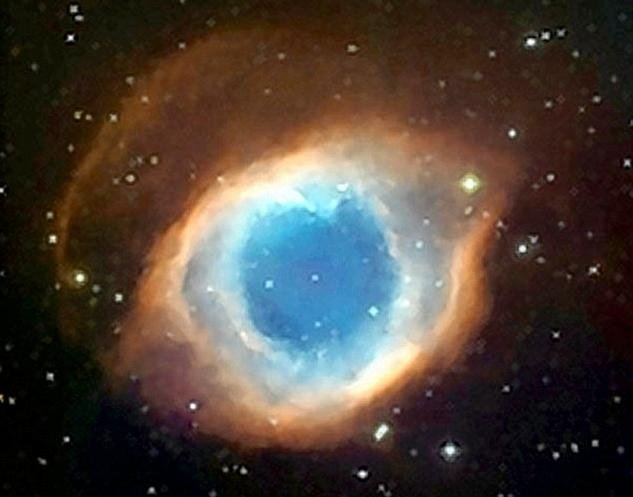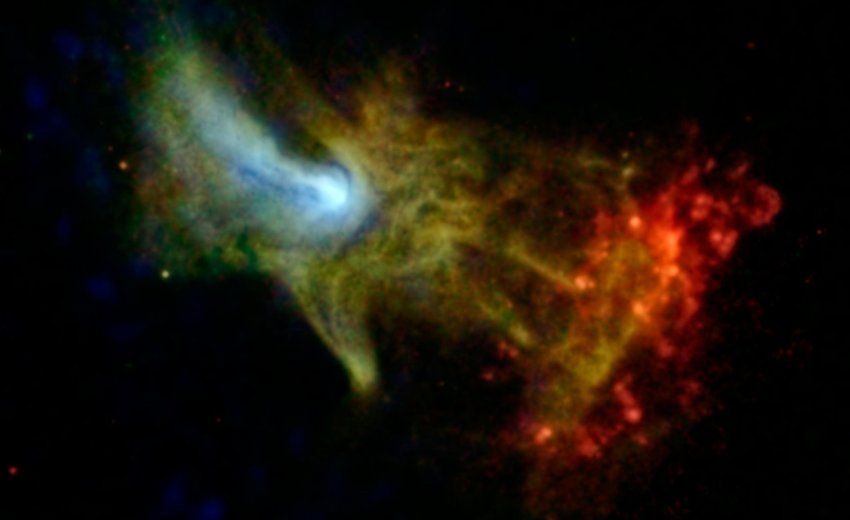
We've already seen pictures of his eye... now we have the first image of the hand of God.
It looks like a hand of God reaching out into the cosmos, but scientists say it's something just as incredible: electromagnetic energy pumped out by a neutron star.
Taken by NASA's Chandra X-ray observatory from it's orbiting 360 miles above the Earth, the recently released photo of Pulsar B1509 captures the X-Ray nebula in a state shaped like a human hand. NASA estimates the shape spans 150 light years, but is caused by a dense neutron star that's just 12 miles in diameter.
"The pulsar is a rapidly spinning neutron star which is spewing energy out into the space around it to create complex and intriguing structures, including one that resembles a large cosmic hand," NASA said in a release.
That energy makes B1509 "one of the most powerful electromagnetic generators in the Galaxy," said NASA, with a magnetic field at it's surface that's 15 trillion times stronger than that of Earth's.
Astronomers believe B1509 is roughly 1,700 years old and is located 17,000 light years from Earth.
The ghostly blue cloud seems to form an outstretched thumb and fingers grasping a burning lump of coal.
This astonishing image was taken by Nasa's Chandra X-ray observatory, which is orbiting 360 miles above the Earth's surface.
A small, dense object only twelve miles in diameter is responsible for this beautiful X-ray nebula that spans 150 light years. At the center of this image made by NASA's Chandra X-ray Observatory is a very young and powerful pulsar, known as PSR B1509-58, or B1509 for short. The pulsar is a rapidly spinning neutron star which is spewing energy out into the space around it to create complex and intriguing structures, including one that resembles a large cosmic hand. In this image, the lowest energy X-rays that Chandra detects are colored red, the medium range is green, and the most energetic ones are blue. Astronomers think that B1509 is about 1700 years old as measured in Earth's time-frame (referring to when events are observable at Earth) and is located about 17,000 light years away.
Neutron stars are created when massive stars run out of fuel and collapse. B1509 is spinning completely around almost 7 times every second and is releasing energy into its environment at a prodigious rate - presumably because it has an intense magnetic field at its surface, estimated to be 15 trillion times stronger than the Earth's magnetic field.
The combination of rapid rotation and ultra-strong magnetic field makes B1509 one of the most powerful electromagnetic generators in the Galaxy. This generator drives an energetic wind of electrons and ions away from the neutron star. As the electrons move through the magnetized nebula, they radiate away their energy and create the elaborate nebula seen by Chandra.
In the innermost regions, a faint circle surrounds the pulsar, and marks the spot where the wind is rapidly decelerated by the slowly expanding nebula. In this way, B1509 shares some striking similarities to the famous Crab Nebula. However B1509's nebula is 15 times wider than the Crab's diameter of 10 light years.
Finger-like structures extend to the north, apparently energizing knots of material in a neighboring gas cloud known as RCW 89. The transfer of energy from the wind to these knots makes them glow brightly in X-rays (orange and red features to the upper right). The temperature in this region appears to vary in a circular pattern around this ring of emission, suggesting that the pulsar may be precessing like a spinning top and sweeping an energizing beam around the gas in RCW 89.
The new photo recalls those of the Helix planetary nebula, whose blue centre surrounded by white clouds earned it the nickname 'the eye of God'.

The hand was created when a star exploded in a supernova, creating a rapidly-spinning 12-mile-wide star called a pulsar, which is deep inside the white blob at the hand's wrist.
The pulsar is spewing out enormous amounts of electromagnetic energy, creating a dust and gas cloud so wide that it would take a light beam 150 years to cross from side to side.
The red disc is a separate cloud of gas. The fingers are thought to have been created as the energy passed from the pulsar to this gas cloud.
Nasa scientists estimate the moment depicted here actually happened 17,000 years ago.
It has taken since then for the X-rays, travelling at 670 million mph, to reach Earth.
